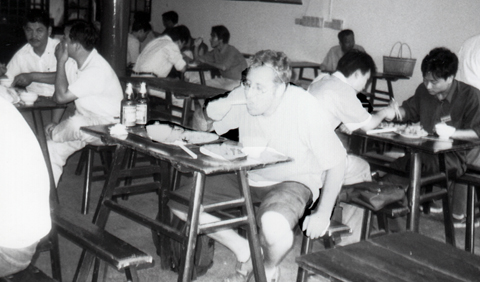Shaoxing绍兴: City of Wine黄酒 and Chou Doufu 臭豆腐 (Stinky Doufu)

Shaoxing: City of Wine and Stinky Doufu is a food lovers paradice if you love these two products.
Shaoxing Wine
The smell of the wine hung heavy in the bar and impregnated the old wooden tables, chairs, floor and beams. Old and young took large gulps and slurped the wine from ceramic bowls. Mah-jong blocks crashed on the table, and chopsticks raced with each other to pick up the last piece of stinky tofu. The owner smiled and exposed his blackened teeth as more bowls of wine were ordered and new customers came in, immediately replacing the departing ones. Welcome to Shaoxing and it’s wine.
Shaoxing: City of Wine and Stinky Doufu: The wine
With a tradition that goes back more than two thousand years, Shaoxing wine continues to be a popular drink enjoyed by millions of Chinese. For the uninitiated it is undoubtedly an acquired taste, but it has nothing to do with other Chinese beverages, such as rice wine, which have more in common with rocket fuel than wine as we know it.
In general, the wine produced in Shaoxing is like a medium sherry, resembling the Oloroso wines from the Jerez region of Spain. However, Shaoxing wine, unlike Oloroso, isn’t made from grapes, but from high quality polished glutinous rice and high grade wheat. The water is provided by the clear and pure waters of the nearby Jianhu lake.
Shaoxing wine is popularly known throughout China as Huangjiu 黄酒, or Yellow Wine. There are several different varieties of Shaoxing wine that take on different shades of colour, ranging from the light yellow that gives the original Shaoxing wine its name, to a dark, almost reddish brown variety.
Types of Shaoxing Wine
Of the many types of Shaoxing wine, the Xiangxue (Fragrant Snow) variety is the most highly appreciated. One particular brand of Xiangxue, Ju Yue Longshan, is served at state banquets. Moreover, some Shaoxing wines have become famous outside China. In fact, a Shaoxing wine was awarded a gold medal at a wine and liquor contest held in Madrid in 1985.
When stored over years, Shaoxing wine becomes more fragrant, more appreciated and more expensive. A Shaoxing wine, when it has been bottled for 30 years, is said to have reached its zenith. Though one type, Huadiao jiu, is sometimes bottled for up to 50 years.
Shaoxing wines can be drunk either cooled or warmed, and tend to have an alcohol content of around 16%. The more expensive types are often served slightly warmed and brought to the table in exotic looking metal wine pewters.
Shaoxing: City of Wine and Stinky Doufu: The Food

Apart from being a popular drink, Shaoxing wine plays an important part in Chinese Cuisine; it is used in all the cooking schools, and adds a special touch to many dishes. Fish, prawns, seafood and chicken especially benefit from its presence. ‘Drunken prawns’, a dish in which prawns are either marinated or boiled in Shaoxing wine, together with ginger and star anise, is absolutely delicious. Before the ready availability of Chinese products in supermarkets in the West, many Chinese cookery books used to recommend the use of Sherry to replace Shaoxing wine.
Shaoxing: City of Wine and Stinky Doufu: The bars
One of the great pleasures of visiting the attractive city of Shaoxing, is to drop into one of the traditional local bars and try a few of the different types of wine. The cheaper wine is usually sold by the bowlful, although in some places you can also buy the wine in a type of pitcher.
Shaoxing: City of Wine and Stinky DoufuStinky Tofu (Chou Doufu 臭豆腐
Opposite the former residence of the writer Lu Xun, there is an absolutely fantastic old bar where you can merrily drink Shaoxing wine and snack on the Chinese variant of ‘tapas’. The ordering system in this bar is typical of traditional Chinese tea houses and eateries: you first go to a counter and check out what they have, the dishes are usually displayed, then you go to another counter and purchase tickets for the dishes you want, and finally return to the food counter, hand over the tickets and take the food to your table. The most popular dish to accompany Shaoxing wine is ‘Chou Dofu 臭豆腐’ which translates as ‘Stinky tofu’. Smoked duck, fried shrimps and fried chestnuts coated in honey are also popular accompanying dishes.
I have just found this rather nice video about Shaoxing, its wine and smelly tofu, on Youtube. They film it in the same restaurant we describe in our 2001 visit. However, it seems that the place has been somewhat sanitised since we were there. But it is great to see that the wooden benches and tables are still there.
The Video is in Chinese with English Subtitles. Click below and enjoy it..











